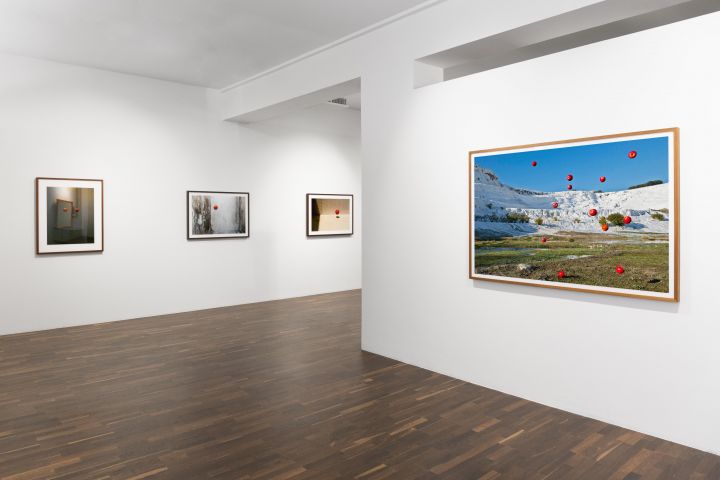Christophe Guye Galerie is thrilled to announce Korean artist Jun Ahn’s (*1981) second solo exhibition ‘On Gravity’ at the gallery. The exhibition shows works from four different series – ‚One Life/Gravity‘, 'Liberation’, 'Invisible Seascape’ and ‚Lucid Dream’, all of which are in some way connected to the theme of gravity and its seeming defiance. On this occasion the exhibition will be displayed throughout the entire gallery. In the series ‘One Life/Gravity’ and ‘Liberation’, Jun Ahn repeatedly throws objects such as apples and rocks into the air and photographs them with a fast exposure time. During the editing process, Ahn selects images which suggest the objects simply float in air, as if revolting against both gravity and fate itself, and thereby tries to expose the transcendence of moments from which all context had been stripped. The series ‘Invisible Seascape’ appears as images of seascapes, but they are seascapes that cannot be found anywhere in nature. Jun Ahn creates digitally combined collages based on high-speed photographic images of waves. Each work is a composed scenery made of waves created by ships on which the artist finds herself. The depicted nature thus consists of components of her travels on the sea. ‘Lucid Dream’ was created during the pandemic, at a moment when the sea, the sky and the birds were symbols of freedom and dreams for many. The series is an homage to the dream of being able to fly that Jun Ahn has dreamt over and over again since her childhood.
‘My mother still remembers the day when I told her that I didn't want to grow up anymore. I can remember that day too. When I was around seven years old, I thought it would be okay not to grow up if it meant not seeing my parents grow older. Maybe this was the first day in my life that I really thought about ageing and dying. Even though no one can choose life for themselves, everyone needs to face loss and death once they are here. That day I realised that life is ultimately a process of dying, much like an object thrown into an environment with gravity. Life comes into being for no apparent reason and without self-determination and inevitably faces death once it has begun. Just like an object that is thrown into the air, then falls down and ends up being shattered on the ground. We call this process 'free fall'. I always thought the word 'free fall' was not a suitable term. When an object is in free fall in the air, it has no way of resisting or doing anything other than falling. Why do we use the word 'free' in such a context?
For this reason, much of my conceptual work uses ‘gravity’ and the phenomenon of ‘free fall’ as a metaphor for ‘memento mori’. As a photographer who uses high-speed photography to explore the structure of the world beyond our visual perception, I often refer to the phenomenon of free fall in my work. With the inevitability of one's life comes the uncertainty of how it will end once it has begun. I consider life to be a ‘phenomenon’ that has its own duration. At the same time, I also consider the free fall of an object as a phenomenon, but one that lasts shorter than our life. So, if life is a process of dying, I want to capture the beauty that comes with it in my work. For my earlier series 'Self-Portrait', I placed my body at the edge of contemporary architecture, in front of the void between skyscrapers and the spectacular view of the city. The various series that then followed are about the beauty of the coordination of objects during the phenomenon of free fall. And I portray them using photography and performances, which I carry out repeatedly.
I ask my family and friends to throw apples or stones into the air again and again. To capture the moment of randomness and coincidence, in the repeated performance of free fall, which is understood in the sense of the ‘life’ of objects, it is hard to think of anyone other than my parents, my sister, my husband and my grandmother who passed away last year. Even though as a child I wished I would not grow up, I am now older than my mother was at the time, when she had just heard from her daughter that she was not ready for her mother to grow old. During the time I have been growing up, the earth has rotated on its own axis as well as around the sun. And even the solar system rotates within the galaxy, in fact even the galaxy moves within the space of the universe. Hence, in infinite space, no one ever stays in the same place. Despite the speed with which we move in the universe, despite the very short lifetime compared to the world around us, people meet and eventually also lose each other. What is celebrated, what is remembered after time has passed, are the beautiful encounters we had at a particular moment.’ – Jun Ahn
